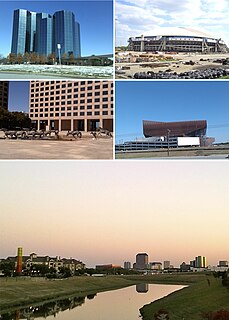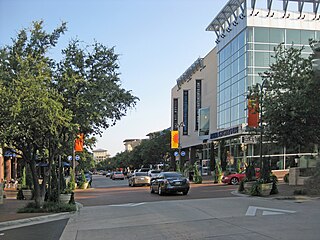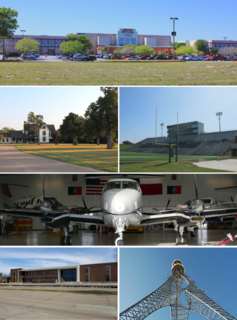
Dallas is a city in the U.S. state of Texas and the largest city in and seat of Dallas County, with portions extending into Collin, Denton, Kaufman and Rockwall counties. With a 2020 census population of 1,304,379, it is the ninth most-populous city in the U.S. and the third-largest in Texas after Houston and San Antonio. Located in North Texas, the city of Dallas is the main core of the largest metropolitan area in the Southern United States and the largest inland metropolitan area in the U.S. that lacks any navigable link to the sea. It is the most populous city in the Dallas–Fort Worth metroplex, the fourth-largest metropolitan area in the country at 7.5 million people.

Fort Worth is the fifth-largest city in the U.S. state of Texas and the 12th-largest city in the United States. It is the county seat of Tarrant County, covering nearly 350 square miles (910 km2) into four other counties: Denton, Parker, Wise, and Johnson. According to the 2020 U.S. census, Fort Worth's population was 927,720.Fort Worth is the second-largest city is in the Dallas–Fort Worth–Arlington metropolitan area, which is the fourth-most populous metropolitan area in the United States.

Tarrant County is located in the U.S. state of Texas. As of 2020, it had a population of 2,110,640. It is Texas' third-most populous county and the 15th-most populous in the United States. Its county seat is Fort Worth.

Arlington is a city in the U.S. state of Texas, located in Tarrant County. It forms part of the Mid-Cities region of the Dallas–Fort Worth–Arlington metropolitan statistical area, and is a principal city of the metropolis and region. The city had a population of 394,266 in 2020, making it the second-largest city in the county after Fort Worth. Arlington is the 50th-most populous city in the United States, the seventh-most populous city in the state of Texas, and the largest city in the state that is not a county seat.

McKinney is a city in and the county seat of Collin County, Texas, United States. It is Collin County's second-largest city, after Plano. A suburb of the Dallas–Fort Worth metroplex, McKinney is about 32 miles (51 km) north of Dallas.

Irving is a city in the U.S. state of Texas. Located in Dallas County, it is also an inner ring suburb of Dallas. The city of Irving is part of the Dallas–Fort Worth metroplex. According to a 2019 estimate from the United States Census Bureau, the city population was 239,798 making it the thirteenth-most populous city in Texas, and 93rd most populous city in the U.S. Irving is noted for its racial and ethnic diversity, and has been ranked as one of the most diverse cities in the United States. Irving includes the Las Colinas mixed-use master-planned community and part of the Dallas/Fort Worth International Airport.

Plano is a city in Collin County and Denton County, Texas, United States. It had a population of 285,494 at the 2020 census. It is part of the Dallas–Fort Worth metroplex.

Coppell is a city in the northwest corner of Dallas County in the U.S. state of Texas. It is a suburb of Dallas and a bedroom community in the Dallas–Fort Worth metroplex. Its population was 38,659 at the 2010 census. A small area in the far northern portion of the city extends into neighboring Denton County.

Grand Prairie is a city in Dallas County, Tarrant County, and Ellis County, Texas, in the United States. It is part of the Mid-Cities region in the Dallas–Fort Worth metroplex. It has a population of 175,396 according to the 2010 census, making it the fifteenth most populous city in the state.

Mesquite is a suburban city located east of the city of Dallas, Texas, in the United States. Most of the city is located in Dallas County, though a small portion extends into Kaufman County. As of 2019 census estimates, the population was 140,937, making it the 22nd-most populous city in the U.S. state of Texas. Mesquite is positioned at the crossroads of four major highways, making locations such as downtown Dallas, Lake Ray Hubbard, Dallas Love Field, and DFW International Airport accessible.

The Dallas–Fort Worth metroplex, officially designated Dallas–Fort Worth–Arlington by the U.S. Office of Management and Budget, is a conurbated metropolitan statistical area in the U.S. state of Texas encompassing 11 counties. It is the economic and cultural hub of North Texas. Residents of the area also refer to it as DFW, or the Metroplex. The Dallas–Fort Worth–Arlington metropolitan statistical area's population was 7,637,387 according to the U.S. Census Bureau's 2020 US Census, making it the most populous metropolitan area in both Texas and the Southern United States, the fourth-largest in the U.S., and the tenth-largest in the Americas. In 2016, the Dallas–Fort Worth metroplex had the highest annual population growth in the United States.
The Mid-Cities is a suburban region filling the 30-mile span between Dallas and Fort Worth. These communities include the cities of Irving, Arlington, Grand Prairie, Lewisville, Flower Mound, Coppell, Grapevine, Southlake, Colleyville, Hurst, Euless, Bedford, North Richland Hills, Richland Hills, Haltom City, Watauga, and Keller.
This article is about the culture of Dallas, Texas (USA).

El Fenix is a popular chain of Mexican restaurants in the Dallas/Ft. Worth Metroplex, (Texas) and the oldest chain of Mexican restaurants in the U.S. The name is Spanish for "the phoenix", the legendary bird which, according to mythology, arose from its own ashes. The chain has its headquarters in Dallas.
Ledbetter/Eagle Ford is a neighborhood in West Dallas, Texas, United States.
Little Mexico is a former neighborhood in Dallas, Texas, encompassing the area bordered by Maple Avenue, McKinney Avenue and the MKT Railroad. Formerly a Polish Jewish neighborhood, it was settled by a wave of Mexican immigrants beginning about 1910, and was recognized as Little Mexico by 1919, becoming a center of a Mexican-American community life in the city that lasted into the early 1980s, with a peak of population in the 1960s. Pike Park and a few structures are the remnants of the historic neighborhood, redeveloped as Uptown, including the Arts and West End Districts.

As of the 2010 United States census, there were 6,371,773 people. The racial makeup of the MSA was 50.2% White, 15.4% African American, 0.6% Native American, 5.9% Asian, 0.1% Pacific Islander, 10.0% from other races, and 2.4% from two or more races. Hispanic or Latino of any race were 27.5% of the population.
The Dallas-Fort Worth (DFW) area has a population of Chinese Americans. In the second half of the 19th century, the area became permanently settled by non-Native Americans, and citizens of Chinese descent began to make the area their home as well. In modern times, the main population of Chinese Americans is scattered around the northern suburbs of the City of Dallas.
The Dallas–Fort Worth area has one of the largest Nigerian American populations in the United States.
The Dallas–Fort Worth metroplex has over one million African-American and the second largest metro population of African-Americans in Texas.












